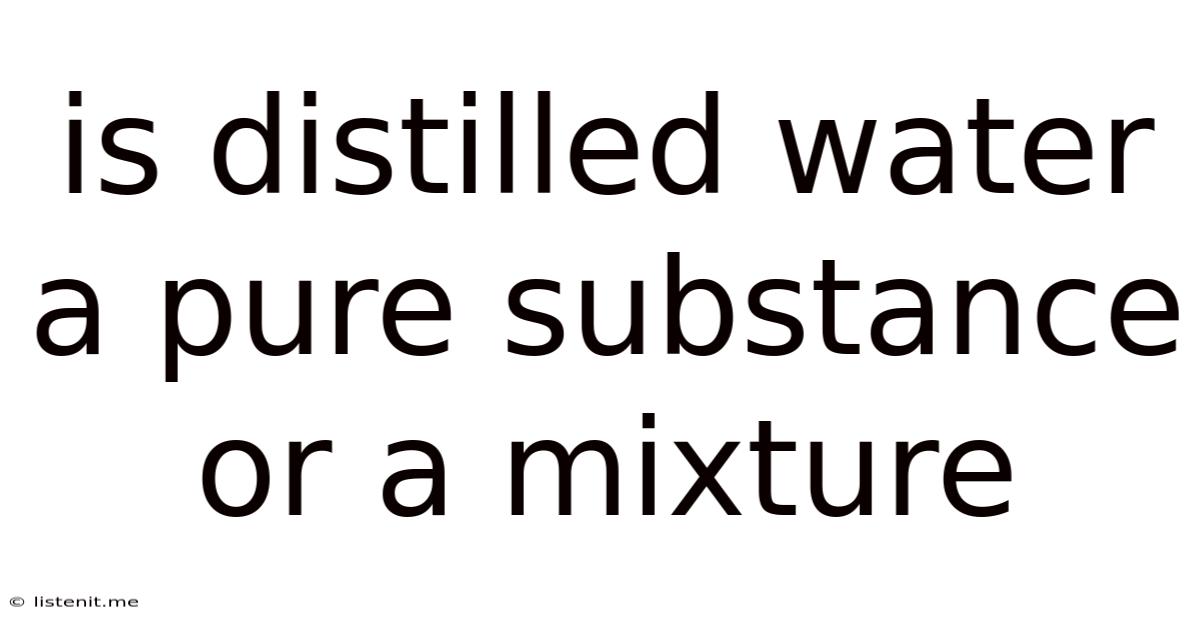Is Distilled Water A Pure Substance Or A Mixture
listenit
May 11, 2025 · 4 min read

Table of Contents
Is Distilled Water a Pure Substance or a Mixture? A Deep Dive
The question of whether distilled water is a pure substance or a mixture often arises in chemistry discussions and everyday life. While seemingly simple, the answer requires a nuanced understanding of the definitions of "pure substance" and "mixture," and the processes involved in distillation. Let's delve into this topic comprehensively.
Understanding Pure Substances and Mixtures
Before classifying distilled water, we need clear definitions:
Pure Substances
A pure substance is a form of matter that has a constant chemical composition and properties throughout its mass. It cannot be separated into components by physical methods like filtration or distillation. Pure substances can be either elements or compounds.
- Elements: Substances composed of only one type of atom (e.g., oxygen, gold, hydrogen).
- Compounds: Substances composed of two or more different types of atoms chemically bonded in fixed proportions (e.g., water (H₂O), sodium chloride (NaCl)). These can be broken down into simpler substances only through chemical reactions.
Mixtures
A mixture is a combination of two or more substances that are not chemically bonded. The components retain their individual properties and can be separated by physical methods. Mixtures can be:
- Homogeneous mixtures: Have a uniform composition throughout (e.g., saltwater, air). The individual components are not visibly distinguishable.
- Heterogeneous mixtures: Have a non-uniform composition; different components are visibly distinguishable (e.g., sand and water, oil and water).
The Distillation Process: A Key to Purity
Distillation is a widely used separation technique that exploits the differences in boiling points of liquids in a mixture. The process typically involves:
- Heating: The mixture is heated, causing the component with the lower boiling point to vaporize first.
- Condensation: The vapor is then cooled, causing it to condense back into a liquid.
- Collection: The condensed liquid (the distillate) is collected separately from the remaining components of the original mixture.
Is Distilled Water Truly Pure? The Reality
Ideally, the distillation process should produce pure water, consisting solely of H₂O molecules. However, achieving absolute purity is challenging in practice. Several factors can influence the purity of distilled water:
Volatile Impurities:
Some substances with low boiling points might vaporize along with the water during distillation. These volatile impurities could include:
- Dissolved gases: Gases like carbon dioxide (CO₂) can dissolve in water and may be carried over during the distillation process, though typically in small amounts.
- Organic compounds: Depending on the source water, trace amounts of volatile organic compounds (VOCs) might be present and partially distilled. High-quality distillation systems minimize this.
Non-Volatile Impurities:
Substances with higher boiling points than water will generally remain in the distillation flask. However, tiny amounts might be carried over through splashing or foaming. These could include:
- Inorganic salts: Minerals like calcium and magnesium salts are common in natural water sources. Distillation effectively removes the majority of these, but trace amounts may remain.
- Heavy metals: Depending on the source water, trace amounts of heavy metals might be present and not entirely removed through the distillation process.
Contamination during Collection and Storage:
Even if the distillation process itself is flawless, contamination can occur during the collection and storage of the distilled water. This can happen through:
- Exposure to air: Contact with air can introduce dissolved gases and other airborne particles into the water.
- Improper storage containers: Using contaminated containers or containers made from materials that leach substances into the water can alter its purity.
Defining "Pure" in a Practical Sense
Given the challenges of complete removal of all impurities, the concept of "pure" in relation to distilled water needs careful consideration. For many scientific and industrial applications, distilled water is considered sufficiently pure and meets the criteria necessary for its intended purpose. However, for specific applications requiring ultra-high purity (e.g., semiconductor manufacturing), further purification steps like deionization or reverse osmosis are necessary.
Conclusion: A nuanced answer
Therefore, while distilled water aims to be a pure substance (H₂O), in practice it is often more accurately described as an extremely pure mixture, containing negligible amounts of various impurities. The purity achieved depends heavily on the quality of the distillation process, the source water, and the handling and storage methods. It's crucial to understand that the term "pure" is relative and context-dependent when discussing distilled water. The level of purity is sufficient for most applications, but for those demanding the highest standards, additional purification techniques are required. Understanding these nuances allows for better informed decision-making regarding the applications and appropriateness of using distilled water.
Latest Posts
Latest Posts
-
1 Mole Of Water In Grams
May 12, 2025
-
Dna Strands Are Held Together By
May 12, 2025
-
How To Convert Hg To Mmhg
May 12, 2025
-
Does Oxygen Lose Or Gain Electrons
May 12, 2025
-
Greatest Common Factor Of 56 And 64
May 12, 2025
Related Post
Thank you for visiting our website which covers about Is Distilled Water A Pure Substance Or A Mixture . We hope the information provided has been useful to you. Feel free to contact us if you have any questions or need further assistance. See you next time and don't miss to bookmark.